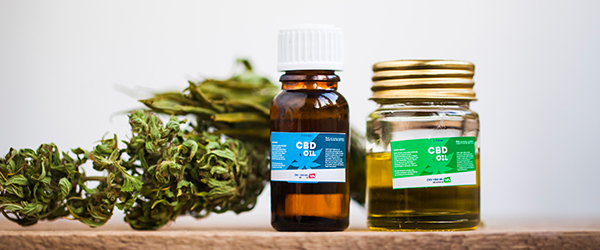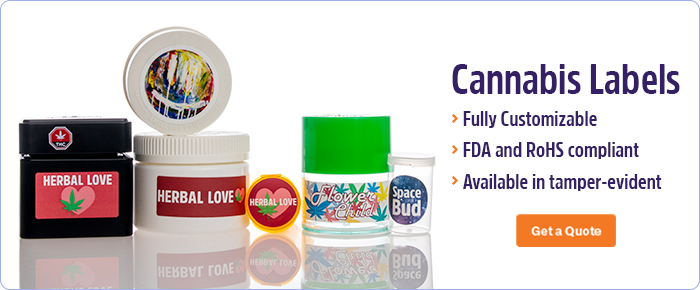 It’s common knowledge in the cannabis industry that printing labels is one of the most important steps in creating a product that’s trusted by buyers. Considering that cannabis has been only recently legalized in limited parts of the world, making well-printed, informative cannabis labels is a potential key differentiator for your business in terms of how the public sees your products, from oils and ground flowers to sprays and edibles.
It’s common knowledge in the cannabis industry that printing labels is one of the most important steps in creating a product that’s trusted by buyers. Considering that cannabis has been only recently legalized in limited parts of the world, making well-printed, informative cannabis labels is a potential key differentiator for your business in terms of how the public sees your products, from oils and ground flowers to sprays and edibles.
Cannabis Label Information
Let’s start with the basics.
According to Canadian law, here is the information that’s required to be on the label:
- Standardized cannabis symbol
- Class of cannabis
- Brand name
- Other brand elements
- Net weight
- List of ingredients
- THC and CBD content
- Nutrition facts table
- Sources of food allergen and gluten
- Expiry date
- Cannabis possession statement
- Barcode
Warning labels are also required. They usually include several of the following:
- Health risks
- Age restrictions
- Habit formation
- Impaired abilities
- Resale and transfer restrictions
- For medical use only
- Schedule I controlled substance
- Not suitable for children
There are several additional product details that are not required on the label, but might provide valuable insight for buyers:
- Directions for use
- Information about the product form
- Specific warnings and precautions
The Essentials
Potency
Potency depends on the amount of either THC or CBD in the product and is usually expressed in percentages or milligrams. The higher the concentration of an active ingredient in a product, the stronger it is.
However, that is not always the case with cannabis, as the cannabis plant has multiple active ingredients that all have their own set of effects. Regardless, the CBD:THC ratio has been set as the indicator of potency.
Language on the Label
When it comes to cannabis products, all information on Canadian labels must be written in both English and French, with the exception of the European Union trivial names and International Nomenclature of Cosmetic Ingredients names.
Standardized Cannabis Symbol
The standardized cannabis symbol must also be included on the label to inform and warn consumers that the product they are buying contains THC. The standardized cannabis symbol is a cannabis leaf inside a red octagon with a white border.
Lab or Grower’s Name
Every cannabis product must include the lab or grower’s name, so the customers know where the product came from and who manufactured it. Such information can be useful for those who like to choose a brand and stick with it.
Batch ID
The batch ID on the label helps the employees in the dispensary and the consumers to connect the product with the manufacturer and receive additional information.
Details About Plant Potency
The label should include the percentages of all extracted cannabis compounds. This will provide a clearer picture for your customers of what to expect from the product. To avoid confusion, note that the information on most cannabis products is usually recorded in metric units.
Total THC
Total THC, sometimes written as THC maximum, is the total amount of THC contained in a product, giving your customers a general idea about how psychoactive the strain is.
The amount is usually written in milligrams, and the recommended dose for new cannabis users is considered to be around 10 mg of THC. For more experienced users, 20 mg is regarded as a potent dose. If it is for medicinal use, the amount might be even higher. Discussions on the pros and cons of cannabis usually revolve around this cannabinoid, so be extra careful.
THCa
THCa, usually written as Δ9-THCa, is a tetrahydrocannabinolic acid and represents the raw, non-psychoactive form of THC.
This will inform your customers that if they want to experience the psychoactive effects of THC, they will need to heat it prior to consumption. This process is called decarboxylation, and it occurs when smoking cannabis or preparing edibles. Similar to total THC, the higher the value, the more psychoactive the strain.
DTHC
When designing a label, total THC and its decarboxylated product aren’t the only things that need be taken into consideration; the rate of aging of THC must also be represented.
The addition of a DTHC or Δ9-THC mark on the label will warn customers that the product already contains an amount of activated THC, indicating that no chemical reaction is required to experience THC’s psychoactive effects. This can be the case even when the percentage of THC may not be very high. However, if the product requires heating, make sure you add the percentage next to this sign.
CBD
Similar to total THC, this number represents the percentage or the amount in milligrams of CBD contained in your product.
CBD is the non-psychoactive component of the cannabis plant, and unlike THC, it will not cause mind-altering effects, no matter how high the dose. CBD is, however, responsible for various stress-relief effects, like complete body relaxation.
CBDa
CBDa, or cannabidiol acid, indicates the potential of the CBD strain used in the product. Through decarboxylation (i.e. heating the CBD product), CBDa transforms into CBD. For recreational use, CBD quantities are usually lower, while strains high in CBD are typically recommended for specific medical conditions.
Other Cannabinoids
THC and CBD are not the only cannabinoids found in the cannabis plant. There are approximately 113 different cannabinoids total that have been identified, including THCV, Δ8-THC, CBG, CBN, and CBC. Even though they are present in smaller amounts, these small molecules still contribute to the product’s overall effects and can bring their own set of health benefits as well. Therefore, it’s advantageous to the buyer to include in the label some information about the full spectrum of cannabinoids found in the product.
Terpenes
Terpenes are recognized as natural and aromatic oils in plants that affect fragrance or taste. There are many different terpenes in the cannabis plant, and they usually produce some of the most appealing scents, such as lavender and pine. Eugenol, piperine, myrcene, pinene, limonene, and linalool are just some of the most popular terpenes found in cannabis.
Terpene profiles can also affect customer experience as they work in combination with cannabinoids to elicit what’s known as the entourage effect, a phenomenon whereby the combination of terpenes and cannabinoids alters the overall potency of the product. Because of the entourage effect, terpenes may affect the psychoactive properties of the strain (potentially providing health benefits as well), so it’s ideal to include some information on the label about what terpenes are found in the product.
Pesticides/Insecticides
One of the main reasons customers prefer buying a properly labeled product is to ensure it is not contaminated with pesticides or insecticides. The levels of both pesticides and insecticides must be under 0.1 parts per million for any product to pass inspection and be regarded as safe for consumption.
Bacterial/Fungal Contamination
Mold and mildew can also be a concern during manufacturing. Fungi, such as yeasts, and large bacterial colonies, like Escherichia coli or Salmonella, can grow in cultivated cannabis leaves, increasing the likelihood of a serious infection post-consumption.
However, there are acceptable levels of several microbes, depending on state regulations, so it is best if you include these numbers on the label.
What Else Should You Know About?
There is additional information that might be useful in situations when a customer cannot choose one product over another based solely only on its THC and CBD levels.
Harvest and Test Dates
These dates indicate when the flower was harvested and tested for pesticides, insecticides, mold and mildew, as well as potency.
Activation Time
Activation time is the amount of time it is likely to take for an individual to begin feeling the effects of inhaling, ingesting, or using a cannabis-based product. It can range from just a few seconds to 12 hours, depending on whether you vape, eat edibles, or use skin patches. This information can be crucial for some consumers, especially for those who are new or use cannabis for medicinal purposes.
Labeling Cannabis That’s Not a Cannabis Product
When cannabis is sold in bulk for export or intra-industry, the label must contain the lot number, packaging date, and contact information of the license holder that sells, exports, or distributes the plant product.
The Bottom Line
When it comes to cannabis product labeling, understanding what needs to be printed can be crucial to maximizing sales and providing the customer with the means to differentiate between high and low-quality products. Therefore, when designing a label, remember to be thorough, as you want to inspire trust among your clients by providing all the relevant information necessary for them to make an informed choice. Hiring an experienced professional to help design your labels is essential as the label (and what’s on it) can make the difference in this competitive market.
LabTAG by GA International is a leading manufacturer of high-performance specialty labels and a supplier of identification solutions used in research and medical labs as well as healthcare institutions.




